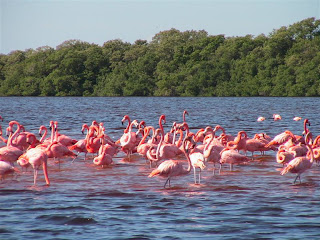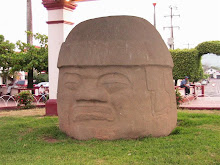This time we'll go to Papantla, in Veracruz state. Little town in the north of this state, it names means 'Place of the noisy bird' in Totonacan language, probably because lots of birds sing at the sunrise...It is a pretty typical town ,with its traditional Zocalo (central place), its church in the high part of the town, and also a Volador statue on the highest part, visible from far away...


The most important dance of the totonacs people is the famous Volador dance. You cannot pass through Papantla without seeing this! This very ritual dance permits to invoke the four ways of the totonacan universe, as also the water, the wind, the earth, the moon and the sun, meaning to say the most important elements for life. It is done by four dancers, wearing white and red traditional clothes, and also by a leader who direct the show with his flute and tambour, from the mast.


You already discovered it, the origin of Papantla comes from Totonacan people. The town probably was created around 1200 A.C. Vanilia was cultivated since prehispanic times in this important production center (which permited various Spanish families generations to get rich), until the vanilia plant was brought to Europe. Papantla importance in the prehispanic world also comes from the fact it was very close to Tajín site.
Much older than Aztec sites, ceremonial buildings of this Totonac state capital began to be constructed in the 1st century. The site got influence from Tehotihuacan as from Toltec civilizations. Its reconstruction began on the 13th century after Chichimecs destroyed it. Then, on 16th century the place was depopulated, when spanishyards arrived.
Much older than Aztec sites, ceremonial buildings of this Totonac state capital began to be constructed in the 1st century. The site got influence from Tehotihuacan as from Toltec civilizations. Its reconstruction began on the 13th century after Chichimecs destroyed it. Then, on 16th century the place was depopulated, when spanishyards arrived.


Finaly, they began to search and dig between 1943 and 1963. You can see lots of pelota fields (a prehispanic ball game which objective is to put rock balls into rings) and pyramids, especialy the amazing niched pyramid. It has 365 alcoves, and it is supposed to be representing a calendar.


You will find various hotels in Papantla, it worths to spend a night there for its nice relaxing ambiance. You can also walk around in the market place, where you will find vanilia of course... Moreover the landscapes are staggering, it really worths the trip !
Enlarge the map









.JPG)
.JPG)
.JPG)
.JPG)
.JPG)
.JPG)
.JPG)
.JPG)














